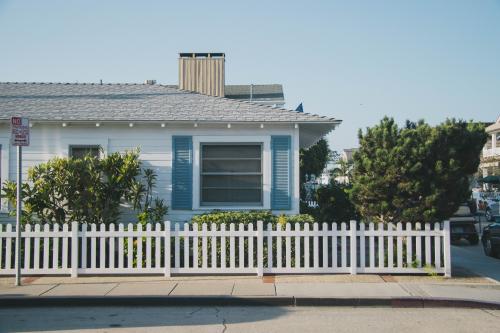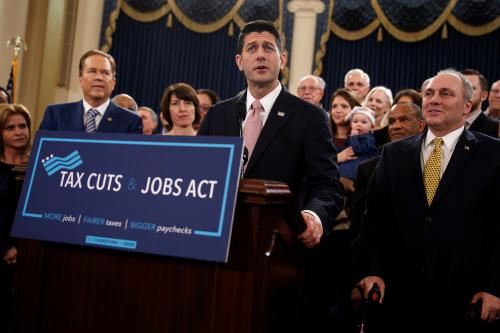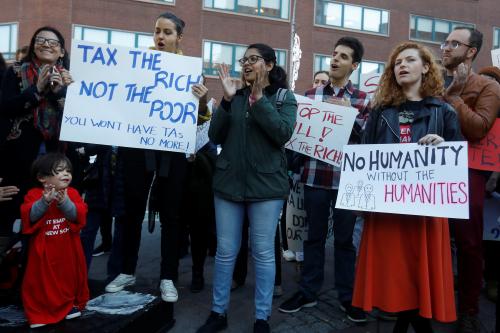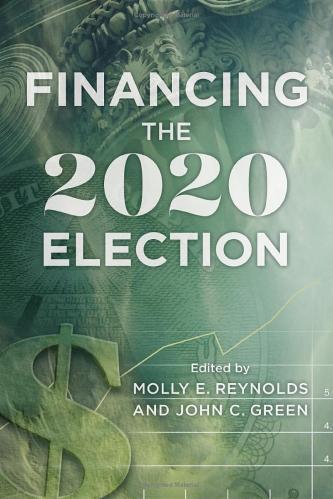The tax bill is widely and rightly being reported as an enormous giveaway to the very wealthy. Taken as a whole, the passage of this shoddy and regressive bill is a disaster for equity in America. But progressives can take heart in one small but not insignificant policy buried in this debacle: the new cap on the home mortgage interest deduction.
First, some background. Republicans decided to pass a tax bill without Democratic support, which left them beholden to a particular set of budget rules. To give as big a cut as possible to the very top without violating those budget rules, Republicans are relying on a mishmash of revenue-raising policies. As my colleague Bill Gale has pointed out, the bill is a six trillion dollar tax cut, partially offset with a four-and-a-half trillion dollar tax increase. (So much for the vaunted Republican anti-tax pledge.)
Some of the Republican revenue raisers are in keeping with rightwing ideological preferences, such as opening ANWR to oil drilling and repealing the individual mandate. Then there are tax increases (like limiting the state and local tax deduction) that are shifted towards rich Democrats in blue states. Some of the Republicans’ other choices, like the use of chained CPI, are just across-the-board tax hikes that will accrue over time.
But one of the tax increase policies is, remarkably, progressive in its effect: the new cap on the HMID, or the home mortgage interest deduction. Over email, I interviewed Isaac Martin, a professor at UC San Diego and one of the foremost contemporary scholars of fiscal sociology, whose recent work examines the impact of the home mortgage interest deduction and whose findings make a compelling case for not only capping HMID but repealing it altogether.
Isaac, can you start by giving us a little overview of what the home mortgage interest deduction is?
The home mortgage interest deduction (HMID) is a provision of U.S. federal personal income tax law that permits personal income tax payers to deduct from their annual income the interest that they paid or accrued during the year on any mortgages that they took out to purchase a first or second home. Under current law, the deduction applies only to interest on mortgage debt of $1,000,000 or less. Under the Republican tax plan, that cap is reduced to $750,000.
The policy has been called “the most regressive piece of social policy in America”—but what’s not to like about homeownership? What makes the policy regressive?
Homeownership is wonderful for many people. It provides us with shelter and good neighbors and a way to save for retirement. But it is not equally good for everyone. If you have bad luck, your home can be a money pit that traps you in a place you don’t like.
Even if homeownership works out great for you, it may impose costs on other people. There is some evidence that homeownership makes us worse citizens: homeowners are more likely than renters to engage in not-in-my-backyard activism that protects property values, but they may actually become less involved in civic activism of the kind that knits our democracy together. Homeownership also may be bad for the natural environment: it encourages us to sprawl across the landscape and squander resources. It has a fiscal cost, too. Thanks to the HMID, we all pay a price in federal income taxes to support other people’s home mortgages. The Office of Management and Budget estimates the cost of the HMID this fiscal year to be $68 billion in foregone income tax revenue. That is revenue that we could spend on public goods that benefit everyone—or, if you prefer, that we could rebate by lowering income tax rates across the board.
The HMID is a particularly regressive way to spend this money in the sense that it provides the most financial benefit to people with the greatest pre-tax incomes. The greater your income, the bigger the mortgage you can take out—and, therefore, the more interest you can deduct from your income. Moreover, the greater your income, the more you save on your taxes with every dollar of that deduction, because the higher your tax bracket, the higher the rate at which those dollars would otherwise be taxed. The HMID is what a cash welfare program would look like in the upside-down: you tell the government all about your sources of income, and then, if your income is high enough, you get a check, in an amount that is bigger the richer you are.
HMID also intersects with decades of racist housing policies. One of the most interesting things about your research is that you quantify the impact of the HMID on the black-white income gap. In fact, you call HMID “a target-efficient racial subsidy for white families.” What does that mean?
A target-efficient subsidy is one that allocates resources to the intended beneficiaries and not others.
Imagine that some evil genius in Congress wanted to design a policy that would spend tax money on benefits for at least some white families—the “target”—while leaving out black families entirely. Suppose further that this evil genius wanted to disguise the goal of the policy. The trick to target efficiency would be find neutral criteria that, at first glance, appear to have nothing to do with being white or black, but that many white families would meet and that most black families would not.
An evil genius like that might come up with something like the HMID: a policy that directs subsidies toward high-income families who have especially easy access to home loans, and who are able to purchase homes in expensive neighborhoods. Obviously there are plenty of white families that do not meet these criteria. But the families that do meet these criteria are mostly white.
And black families are mostly left out. Black families have lower incomes than white families, on average. On average, they also have much less financial wealth that they can put towards a down payment. They often have access to home loans only on worse terms, and they generally do not have the same opportunities to buy houses in the same neighborhoods on the same terms as white families with the same incomes. Some of these disadvantages result from racial discrimination, plain and simple, and some of them might be thought of as a kind of compounded interest on the racial discrimination that occurred in decades past. The bottom line is that black families are much less likely than white families have the big incomes and big mortgages that get you a big bang for your buck from the HMID.
Some black homeowners and other homeowners of color do benefit from the HMID. But not many and not much.
My other favorite thing about your paper is that you attempt to design a policy even worse than HMID, which you call the “Mad Max” scenario. Can you tell us a little about that?
If you ask who would benefit from getting rid of the HMID, the answer depends on what we would do with all the extra revenue we would get if we taxed the income that homeowners spend on mortgage interest. There are infinitely many ways to spend that money. So instead of pretending there was only one answer, I set out to identify the best and worst alternatives from an egalitarian standpoint.
The most egalitarian alternative would follow what the philosopher John Rawls called the “maximin” rule: to maximize the well-being of the people who are the least well-off. The idea here is to equalize incomes from the bottom up, by redistributing first to the poorest, and then to the next poorest, and so on, topping everyone up until there is an even floor under the income distribution. This imaginary scenario gives us a way to measure the maximum amount of redistribution we could accomplish if we got rid of the HMID. We simulate what the income distribution would look like if all home mortgage interest were taxed and the extra revenue were redistributed according to the maximin rule.
The opposite extreme is a social policy that un-equalizes incomes by redistributing in favor of people who are already rich. At the limit, you can imagine a scenario in which the federal government gets rid of the HMID, thereby raising a bunch of additional revenue, then identifies the one richest guy in the country and gives all of that extra revenue to him. If you saw Mad Max: Fury Road, you’ll recognize why I called this scenario “Mad Max”: that movie depicts a dystopian society in which one person, Immortan Joe, accrues all of the income and controls all of the wealth.
When you compare these scenarios, what you learn that the income distribution in our current system with the HMID is actually not that different from what it would be if we got rid of the HMID and redistributed the revenue according to the Mad Max rule. Another way to say this is that the HMID is already pretty close to the dystopian extreme.
Ok, so why have we been stuck with this policy that is only marginally better than a dystopian nightmare? In the past, legislators have found it difficult to do away with HMID or even to impose limits on it. Why is that?
That’s the $68 billion question. The historical sociologists Monica Prasad and Joshua McCabe are both doing interesting research on why the HMID has stuck around so long. Lots of other forms of consumer interest used to be deductible, and the Tax Reform Act of 1986 got rid of many of those deductions—but not this one. The HMID is popular with homeowners, who tend to be likely voters. But it may be the influence of the housing industry that is particularly responsible for keeping it in there.
The new tax bill brings down the cap on HMID from $1 million to $750,000. Based on your research, do you have a sense of what impact we should expect to see from this policy (taken apart from the rest of the tax bill, of course)?
In the short run, this provision will slightly increase income taxes on some rich people. In particular, those who have more than $750,000 in mortgage debt won’t get to deduct quite as much interest from the income they report to the IRS. It’s possible that some of them will decide to buy slightly less luxurious houses as a result of this provision, but I wouldn’t expect it to have much of an impact on the housing market. Its effect on the overall distribution of post-tax income will be basically negligible.
In the long run, the new cap brings us closer to the day when the HMID can be abolished altogether. The cap is not indexed for inflation. Today, any house that you need a $750,000 mortgage to buy is still an amazing luxury. But $750,000 is not worth what it used to be, and tomorrow it will be worth even less. As long as prices continue to rise, more and more homeowners will find themselves over the cap, and eventually, when nobody derives much financial benefit from the HMID any more, the politics will look much more favorable to repeal. That is more or less the story of how the United Kingdom got rid of the mortgage interest deduction.
So there you have it, the only good news for egalitarians in a cartoonishly regressive tax bill. Unfortunately, the HMID cap is passing as a part of “Mad Max”-style legislation.










Commentary
The only good thing about the tax bill
December 20, 2017